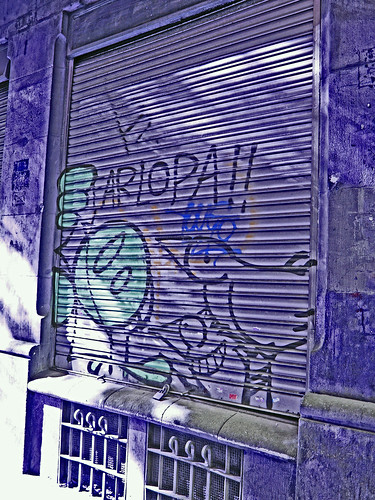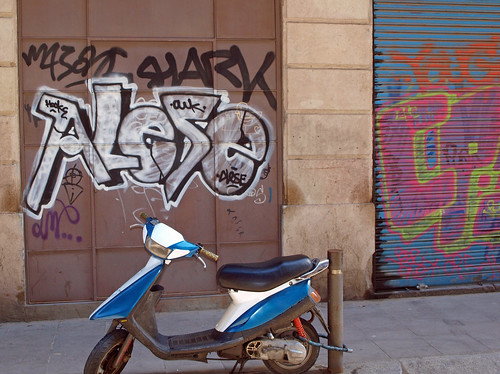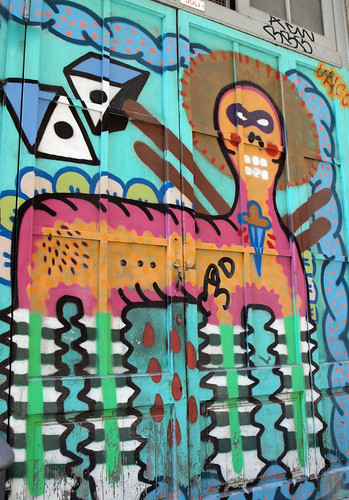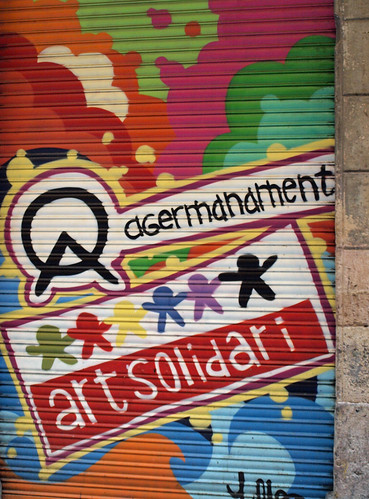One of the things that I love about Barcelona is that there's always some sort of cultural event going on, and this month's featured one is the Barcelona Jazz Festival. I love jazz, though I'm a bit ashamed at how casual I am about pursuing my interest in it- ask me how a certain song goes, or who wrote a specific piece, and I'm usually at a loss. But since there are events going on all around town through the end of November, I figured that now would be as good of a time as any to five into the scene and check out some groups.
Last night, I went with my friend Carlos to see Herbie Hancock and his 5-piece band play a three hour set at the Palau de la Musica Catalana. I have to admit that while I've definitely heard of Herbie Hancock before, the only song of his I can actively remember listening to is a pop duet with John Mayer (which in my defense is quite kick-ass). But of the 6 songs played, I recognized the melodies of two or three of them, which pleasantly surprised me. I guess all those jazz concerts at UHS exposed me to a pretty wide variety of artists, though I could have learned a lot by actually reading the programs instead of making paper airplanes out of them...
While the music was top quality, the show was almost stolen by the venue. The Palau de la Mùsica Catalana is a modernista masterpiece, designed by Domènech i Montaner, a contemporary of Gaudí. While the outside is more restrained compared to other modernista buildings (for instance, Casa Batllò, on the right in the picture), the inside can only be described as whimsical, in the best possible sense. The rainbow-colored stained glass windows on every wall give the space an open, breezy feel, and the huge skylight that drops down in the middle of the ceiling seems to connect the hall with the world outside. There are mosaics on almost every surface, and giant sculptures burst out from the walls (occasionally leading to obstructed views, as I found out in March when I went to a guitar concert at the Palau). Some pictures I took in March are below, but to get a better sense of the space, check out this website:
So I could use a little advice. Ever since I started this blog, I've been thinking of ways to make its design cleaner, clearer, and generally more snazzy. Yet every time I try to change things around, I'm thwarted by my lack of technological ability, and my lack of aesthetic appreciation. The current design is basically the best and most fool-proof thing I could think of, but ideally I'd like something a little more stylized and pretty.
That's where you guys come in. Does anyone have any tips on how I could sharpen up the look of this site? Either by changing the background colors, adding a new template, changing the title picture, really anything- all advice is welcome. Just leave a note in the comments section, and I promise that I'll take it into consideration. :-)
You can stop worrying: I am still alive and well, and I haven't "gone Spanish" and forgotten my prior life in the US. My lack of updates has less to do with being lazy (though I can't deny that I've been guilty of that), and more to do with a schedule that's hardly left me time to eat, not to mention reflect and write. But with my Catalan professor having taken ill this week, I have some free time to catch you all up on my life these past two weeks.
The main reason for my suddenly jam-packed life is the Teaching English as a Foreign Language course that I've enrolled in. Five days a week for between 3 and 8 hours a day, my 16 classmates and I learn pretty much everything there is to learn about basic ESL pedagogy, a task that's made much more difficult by the fact that no one has taken a basic English grammar course since 6th grade, if they've taken any at all. I'm one of the lucky ones who has some grammar background (thanks Mr. Tacke!), and having learned two foreign languages has been an incredible help, especially in comparing grammar forms to understand English. Still, to say that it's like drinking from a fire hose would be an understatement. Passive vs active voice, modal verbs, the seven different ways you can construct the future tense, adverbs of frequency- we're having to absorb as much of this as we can, and hope that we can regurgitate enough of it back out on the final exam to pass the course.
Besides the classroom section, we also have to teach 6 lessons to a group of English language students, who we affectionately, but appropriately, refer to as our "guinea pigs." Class sizes range from 4 to 17, and people's abilities range pretty widely, too, which makes for some tough teaching. This, combined with the our unfamiliarity with basic ESL teaching methods, has made our time in the classroom quite the rollercoaster ride, the difference being that we're paying significantly more for these classes, there's no safety belt, and the entire ride is inverted. Hope you brought your barf bag.
Anyways, all of these challenges bring me back to the title of the post. For me, the hardest thing about teaching has been making sure that my students are understanding what I'm trying to teach. Since we're all new teachers, it's hard to judge the difficulty of a lesson that we're planning to give. Since we don't have much knowledge of their abilities, even if we know how hard a lesson will be, it could be completely inappropriate for the students that show up. And since students want to impress their teachers, they won't admit to not understanding a grammar point or vocab word, and instead just nod their head and act like they get it.
What I've realized in my two weeks of classes is how vital it is to put myself in my students' shoes, and try to see what I'm doing from their perspective. Being a native speaker, it's hard to understand just how diffucult learning English must be and how different it is from other languages, and it's easy to assume that students are getting everything, or when they aren't, they're just not trying hard enough. But the reality is probably different, and to be able to get your points across, you have to understand what it's like to be on their side. In this way, effective teaching, almost more than anything, seems to be about empathy. Of course, teachers have to prepare materials, practice their delivery, and carry themselves in a certain way. But there's that other element that plays a big part too.
After a week-long search, I finally signed up for a gym- the Can Ricart complex esportiu. I would try to describe it in this post, but words can't really do it justice- it is beyond cool. All I can say is that it the Dodge Fitness Center, and, dare I say, the SF JCC, have nothing on it.


Amazingly enough, and despite its 25m pool, huge basketball court, and excellently-equipped fitness area, this isn't some tony private health club. Nope, this beautiful facility is run by the city of Barcelona, for the benefit of everyone who lives there. Like most great things, there is a cost involved, but it's pretty minimal- 35 euros a month to go at any time of day (it's only 25 if you just go in the mornings), plus 15 euros more for towel service and access to the spa. And it attracts a wide variety of people- lots of young guys and women, but also a fair share of older people who want to stay/get in shape. Yay for European governments caring about their citizens.
The story behind Can Ricart is pretty cool- the building was originally built in the mid-19th century as a textile mill by the Ricart Company, one of Cataluyna's biggest manufacturers and a vital part of the region's and country's economy (think of it like the Spanish version of GE). By the late 20th century, times had changed, the factory was closed down and abandoned, and eventually it fell into the city's hands. After a multi-year restoration project, it reopened in 2006 as a fitness complex, though they preserved many of the architectural details from when it was a factory- check out the wrought-iron columns and staircase in the exercise room (second picture).
One downside to the gym is that it's a 15 minute walk from my apartment, though perhaps that will make going to work out more of an event, and thus make me more excited to go. We'll see about that. But, if any of you want to experience the glory that is Can Ricart, I do have 2 guest passes.... which I will gladly hand over in return for a visit to Barcelona. :-D
 Catalans have a number of somewhat bizarre (at least to an outside observer) cultural obsessions- fireworks, staid group folk dances, and this adorable little guy (which you can order here, just in time for Christmas!). Food is another fecal, I mean focal point of Catalan culture, and this time of year, Catalans come together in a shared preoccupation for bolets, or wild mushrooms. Families across the area spend their weekends up in the Pyrenees, digging around the woods in a passionate search for all sorts of varieties of mushrooms. In bookstores, there are shelves full of books on shrooming, with tips on the best time of year to go (right after it rains), the best areas for different varieties, and the vital information on how to tell deadly from non-deadly types.
Catalans have a number of somewhat bizarre (at least to an outside observer) cultural obsessions- fireworks, staid group folk dances, and this adorable little guy (which you can order here, just in time for Christmas!). Food is another fecal, I mean focal point of Catalan culture, and this time of year, Catalans come together in a shared preoccupation for bolets, or wild mushrooms. Families across the area spend their weekends up in the Pyrenees, digging around the woods in a passionate search for all sorts of varieties of mushrooms. In bookstores, there are shelves full of books on shrooming, with tips on the best time of year to go (right after it rains), the best areas for different varieties, and the vital information on how to tell deadly from non-deadly types.
In Catalan class last year, Xavier mentioned that going bolet-hunting in the fall is quite a big deal, but I never realized just how big a deal it was until tonight. On prime-time television (which of course was at 10 PM) on the Catalan equivalent of NBC, there was a full hour reality TV show on families going bolet-hunting in the mountains- kids running off into the woods while calling out "where are you, Mr. Bolet," fathers who followed them with a videocamera shouting words of encouragement, and mothers, back in the car, looking like they would rather be anywhere else. According to my roommates, this is a fairly popular show, and pretty representative of how some Catalans get wrapped up in the season.
Anyone want to do some mushroom hunting soon?
Three weeks into my time in Barcelona, I can finally justify my existence here. My Catalan class started up on Monday, and for at least the next four weeks, I'll be spending my Monday through Thursday evenings at the University of Barcelona working on my "Oral Agility" (which I believe refers to speaking skills). My professor is a lovely woman named Laura, who fits many stereotypes about Spanish women- she has a deep baritone voice, spends a lot of time in the sun, and is very opinionated and enjoys making broad statements. She is a fantastic teacher, however, willing to correct us when we make mistakes, but always in a reassuring way.
Given the class' name, it's not surprising that we spend almost all of our time talking, debating, and doing group work exercises, which has been not only a great way to work on my pronunciation, but also to get to know my classmates. There are around ten of us, though not everyone comes to class all the time- chalk that one up to the fact that none of us are getting graded. The majority of my classmates are from Europe- two each from Italy and Spain, and a Romanian- but there are also people from Peru and Brazil. What they all have in common, though, is that they not only speak Spanish fluently, but most of them already speak one or two other languages. By far the most impressive of the group is Radu, the Romanian philology student, who I think could carry on a conversion with any European, regardless of where they're from- Romania, France, Italy, Spain, England, Germany, Austria, Switzerland, and Barcelona, as far as I know right now. What's been interesting to notice is that the people who already speak multiple second languages are those who are getting the hang of Catalan the quickest. Is it because they have a natural knack for languages, or because they have experience learning new ones?
People's motivations for taking the class have been fascinating to hear, and I think reveals a lot about language politics in Calatunya. I wrote before about how everyone at the University is insistent on speaking Catalan; it turns out that the official language of the University is Catalan, meaning that all official communication, documents, and most classes are in the language. All of my classmates are students at the University, and they all have stories about not being able to understand their classmates, or worse, their professors and exams. For them, this class isn't just to pick up another language, or to be able to go shopping at the market and not look like a tourist, but a necessary skill to have so they don't fail out. The fact that the University conducts all of its business in Catalan, and makes my classmates take this class, says a lot about the importance of Catalan to Barcelonans- as a point of difference to the rest of Spain, and as a way to hold on to and build off of their past.
This first week has been a big fish-out-of-water experience. Not only am I the only American (and thus the resident expert on all cultural exports), but I'm the only one who's taking Catalan for fun, and not to survive in University classes. My speaking skills are weaker and vocab is smaller than my classmates, but then again, I've only taken two semesters, and I've only been speaking it consistently since I got into town three weeks ago. There have been other highlights and funny stories from class, but since this post is getting long, I'll save those for another time. Stay tuned.
With the possible exceptions of giving instructions to a plastic surgeon or trying to talk your way out of getting arrested, few foreign language exchanges are more fraught with peril than going in for a haircut. Challenges include knowing the appropriate vocab (bangs, layering, highlights, tapering, curved neckline, etc), trusting a new barber, and worst of all, hoping that this new barber doesn't ignore your instructions and instead give you whatever the popular hairstyle is in that particular country.
In Chile, where everyone and their mothers (literally) had a mullet or some variation on the theme, one had to be especially cautious about getting a haircut, because barbers tended to treat gringos' hair as blank canvases to practice hairstyles they would later give native Chileans. For my only haircut there, despite my explicit instructions ("Por favor, no quiero chocopanda" - Please, no mullet), I walked out looking like something out of a Jeff Foxworthy skit, though I did get many compliments from my Chilean friends on my chic 'do.
Unfortunately, Spanish hairstyles seem to be stuck in the 80s as well, but on Friday, I decided to throw caution to the wind and get a trim. Before heading to the salon, I boned up on my hair-related vocab, told myself that in the worst case, I could just shave my head, and downed a glass of wine. Nerves calmed, I let the barber tell me how he wanted to cut my hair, and I closed my eyes to wait to see how it turned out.
I'm happy to say that I don't have a mullet. Perhaps the best description for the hairstyle I got is "Euro-trendy"- short on the sides, a little longer on top and in front, with my bangs swept over to one side. I don't know if I'd be caught dead with this in the US, but in Barcelona, it feels acceptable, maybe even a bit... stylish? Jeez, I didn't think I would have ever used that word to describe myself.
(Unfortunately, I don't have any pictures, but I'll post some when I do.)
One of the fascinating aspects of Barcelona otherwise clean and proper street life is the ubiquitous graffiti on the buildings lining the sidewalks. As opposed to US graffiti, which seems random and destructive, here it has more of a "street art" appearance, with vibrant designs and messages. The graffiti in Barcelona is especially striking whenever the shops are closed: the lowered metal gates are covered in colorful markings, pictures, and designs, which frequently related to whatever is being sold behind them. During siestas and weekends, this street art forms a striking backdrop to the everyday activities that take place on the sidewalk, which makes for some pretty cool pictures.
Last Sunday, I walked around the Raval, taking pictures of some of the more interesting designs. You can find many of them here, but I've also attached a couple of shots below.




Last Monday night, I went to Rosh Hashanah services with the local Reform congregation. A lot like stumbling onto the Democrats Abroad group in Barcelona, I was very lucky to find this, and just in the nick of time. At the debate party on Saturday, I met a fellow young Jew, Josh, who has been living in Barcelona for a year teaching English at a private school. Very graciously, he and his boyfriend invited me out afterward to a festival/concert put on my the city government in honor of Ramadan (Barcelona has a very large number of Muslim immigrants from Pakistan and South Asia), where we drank Moroccan mint tea, checked out the delicacies at the food booths, and listened to some very eclectic and diverse music acts from around the world. As we split up later that night, we exchanged contact information, which led to us meeting up two nights later at the Gran Hotel Catalonia ballroom for services.
The services themselves, being mostly reform in format, were familiar, but the congregation was a lot different than anything I had experienced before. Not surprisingly, the Jewish community is small here. I would say that there were an equal number of expats at the service than locals, and even among the locals, many are originally from Argentina. Given the past 500 years of Jewish history, or lack thereof, in Spain, I wasn't terribly taken aback. (Though before the Inquisition and expulsion of the Jews from the Spanish Empire in 1492, Barcelona was known for its religious toleration. One of the oldest synagogues in Europe is there, and the park near my house, Montjuic, or Mount of the Jews, takes its name from a Jewish cemetery.) However, even though many people were not native speakers, the services were conducted in Spanish- and even the transliterations were in Spainsh, which took a bit of getting used to. Baruj ata Adonai, elojeinu melej a-olam, etc...
Perhaps the small number of Jews here is related to the slightly intimidating security measures that I encountered in trying to get into the services. To get on the guest list, I had to email the congregation with my name, passport number, the name of my congregation in San Francisco, and why I wanted to go to services with them. The next morning, with my Jewish identity confirmed, I got a call from the secretary with the time and address of the services. Arriving at the hotel, I was asked what I was going there, and after responding that I was here for Erev Rosh Hashanah, was further interrograted Mossad-style about who I talked to on the phone, what the name of the congregation was, and when I had first gotten in touch with the temple. Finally, after 5 minutes, some misunderstandings, and Josh's vouching for me, I was able to get in.
Were the security measures necessary? I can understand, given Judaism's somewhat complicated history in Spain, if Jews here feel a little uneasy about being too outspoken or conspicuous. Many Jews here were originally from other parts of Europe who came to Spain fleeing the Holocaust, and who understandably might be scared to practice their religion openly. But I can't help but wonder if the security measures do more harm than good. Barcelona is an incredibly diverse and tolerant city, with people from all over the world, and of all different lifestyles, living and working together. And maybe if us Jews practiced their religion openly, people would see us for what we are, and not much different than everyone else.
I could be totally quixotic. But maybe a little openness could do wonders for being more accepted. And if it helps a certain non-fluent 23 year old trying to get into his first Spanish-language service, that's a plus, too.
It seems that I have a bit of catching up to do, not just due to the amount of time that's passed since I've blogged last, but also because of how hectic this week's been. Some highlights:
-The Festa de la Mercé, the annual week-long pyrotechnical orgy that I blogged about earlier, came to an end last Wednesday with an enormous fireworks show on Montjuic, the hilltop park a few blocks from my apartment. My ears might still be ringing from the 30+ minute series of explosions, and I didn't even leave my apartment.
-Officially registered for classes. This wasn't quite as easy as it should have been, since I had to run around town to get various forms stamped and deposit money into bank accounts, but after a two day adventure, my spot is confirmed. Registration was also made a lot more difficult because the university is insistent on using Catalan everywhere, including speaking it to people who don't understand it well. Like myself. It's actually a little bit ridiculous- even to questions asked in Spanish, they respond in Catalan. At least I didn't have it quite as bad as the exchange students in front of me, who I overheard saying to each other as they left, "Did you understand any of that? I really don't think that was Spanish." I suppose total immersion is the best way to learn a language, but when giving instructions on something as important as registering and paying for classes, you would think that they'd want to make sure you understood what they were saying.
As for my course, I'll be taking a high level beginners class, which has the slightly amusing title "Agilitació Oral." Since my Catalan pronunciation leaves a lot to be desired, the more oral agility I can get, the better off I'll be.
-Watched the Democratic Debate with 100 other Obama supporters at a Democrats Abroad meeting. This was SUCH a godsend- I had been looking around for a week trying to find Americans in Barcelona who wanted to watch the debate, when I stumbled on a Google group of the local chapter of Democrats Abroad. The debate watching party was everything you would expect it to be, in a room filled with die-hard Democrats: people shouting down McCain, cheering every Obama point, and spontaneously bursting into pro-Democratic chants. And of course, in case you were wondering, the unanimous choice for the debate winner was Obama.





